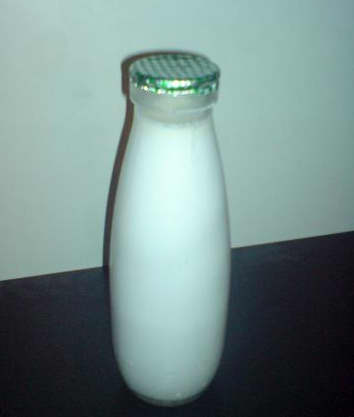Post by Bonobo on Jan 8, 2017 13:25:49 GMT 1
I hope you know that milk, designed by nature for babies, is harmful to adult mammals, also humans. 

Fermenting milk reduces the content of lactose in milk which is the main problem for our digestive systems.
About 3/4 of The World is Intolerant to Lactose
The main carbohydrate in dairy is lactose, a “milk sugar” that is made of the two simple sugars glucose and galactose.
When we’re infants, our bodies produce a digestive enzyme called lactase, which breaks down lactose from mother’s milk. But many people lose the ability to do that in adulthood (3).
In fact, about 75% of the world’s population is unable to break down lactose as adults, a phenomenon called lactose intolerance (4).
authoritynutrition.com/is-dairy-bad-or-good/
That`s why it is good to ferment milk. I chose kefir.
en.wikipedia.org/wiki/Kefir
The slow-acting yeasts, late in the fermentation process, break lactose down into ethanol and carbon dioxide.[citation needed] Depending on the process, ethanol concentration can be as high as 1–2% (achieved by small-scale dairies early in the 20th century), with the kefir having a bubbly appearance and carbonated taste.[citation needed] This makes kefir different from yogurt and most other sour milk products where only bacteria ferment the lactose into acids. Most modern processes, which use shorter fermentation times, result in much lower ethanol concentrations of 0.2–0.3%.[citation needed]
As a result of the fermentation, very little lactose remains in kefir. People with lactose intolerance are able to tolerate kefir, provided the number of live bacteria present in this beverage consumed is high enough (i.e., fermentation has proceeded for adequate time). It has also been shown that fermented milk products have a slower transit time than milk, which may further improve lactose digestion.[11]
This picture shows a glass bottle of kefir from a Krakow region producer which I coul already buy in my childhood and it has been still produced till today in the same form. The kefir is a bit fizzy and wonderfully sour. I tried many other kinds but this one is the best, Simply, perfect.

However, those small glass bottles are a bit inconvenient (I have kefir for lunch at work) to transport (aluminium cap which easily leaks or even falls off) and handle after using (deposit!)
That is why I make my own kefir in plastic milk bottles.
Inoculation is easy. All recipes available on the net advise you to use special kefir grains. I don`t go that far. I just pour a little of my fav kefir into a bottle of regular (raw) milk and wait a day or two, depending on the temperature. Then I use newly fermented kefir to inoculate next bottles and so it goes.
PS. Some radicals claim that all dairy is hafmful and should be rejected in your diet. I am not one of them.
European food here polandsite.proboards.com/board/25/capricious-gourmet
European food here polandsite.proboards.com/board/26/confessions-idle-gastronome


Fermenting milk reduces the content of lactose in milk which is the main problem for our digestive systems.
About 3/4 of The World is Intolerant to Lactose
The main carbohydrate in dairy is lactose, a “milk sugar” that is made of the two simple sugars glucose and galactose.
When we’re infants, our bodies produce a digestive enzyme called lactase, which breaks down lactose from mother’s milk. But many people lose the ability to do that in adulthood (3).
In fact, about 75% of the world’s population is unable to break down lactose as adults, a phenomenon called lactose intolerance (4).
authoritynutrition.com/is-dairy-bad-or-good/
That`s why it is good to ferment milk. I chose kefir.
en.wikipedia.org/wiki/Kefir
The slow-acting yeasts, late in the fermentation process, break lactose down into ethanol and carbon dioxide.[citation needed] Depending on the process, ethanol concentration can be as high as 1–2% (achieved by small-scale dairies early in the 20th century), with the kefir having a bubbly appearance and carbonated taste.[citation needed] This makes kefir different from yogurt and most other sour milk products where only bacteria ferment the lactose into acids. Most modern processes, which use shorter fermentation times, result in much lower ethanol concentrations of 0.2–0.3%.[citation needed]
As a result of the fermentation, very little lactose remains in kefir. People with lactose intolerance are able to tolerate kefir, provided the number of live bacteria present in this beverage consumed is high enough (i.e., fermentation has proceeded for adequate time). It has also been shown that fermented milk products have a slower transit time than milk, which may further improve lactose digestion.[11]
This picture shows a glass bottle of kefir from a Krakow region producer which I coul already buy in my childhood and it has been still produced till today in the same form. The kefir is a bit fizzy and wonderfully sour. I tried many other kinds but this one is the best, Simply, perfect.

However, those small glass bottles are a bit inconvenient (I have kefir for lunch at work) to transport (aluminium cap which easily leaks or even falls off) and handle after using (deposit!)
That is why I make my own kefir in plastic milk bottles.
Inoculation is easy. All recipes available on the net advise you to use special kefir grains. I don`t go that far. I just pour a little of my fav kefir into a bottle of regular (raw) milk and wait a day or two, depending on the temperature. Then I use newly fermented kefir to inoculate next bottles and so it goes.
PS. Some radicals claim that all dairy is hafmful and should be rejected in your diet. I am not one of them.
European food here polandsite.proboards.com/board/25/capricious-gourmet
European food here polandsite.proboards.com/board/26/confessions-idle-gastronome






